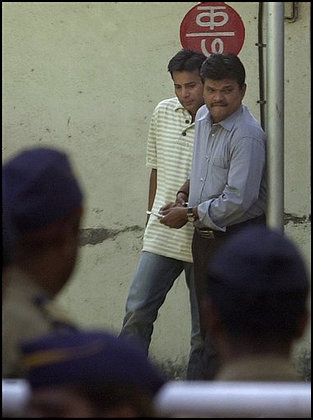It was a spectacularly large head, nice enough to admire, but rather a liability when moving.
Able and Cable had been struggling to fit it through the door of the apartment for nearly twenty minutes. It had become that dreaded thing, an Ordeal, probably the single greatest challenge to their moving efforts since the day they had been asked to move a giant flying saucer covered with a mysterious viscous fluid. They had finally solved that problem (funny what you can do with a hairdryer!), but moving this head into the apartment posed an almost insurmountable problem.
They had tried half a dozen angles of attack as well as various diagonals. They had tried rotating the head. They had even tried inserting the body first and pulling the appendages, though that turned out not to work either. No matter what they did, the head got stuck, either at the massive, protuberant ears, or the bulbous nose.
It truly was an extraordinarily large head. It occurred to them that the tenant would have a hard time ever leaving the apartment with the head, and they thought about cautioning him about this likely issue. But Able refrained from saying anything (and Cable followed suit), mainly along the lines that it was their job to move the tenant and his possessions
into an apartment. After that it was the tenant's business. This particular tenant apparently owned a kind of brace that enabled the head to move around, so perhaps he also owned other contraptions that might make it a bit easier to enter and leave buildings. But if that were the case, why not use the device now?
After they had exhausted every conceivable position, Able and Cable tried using sheer force to get the head through. A shove and a grunt -- but nothing doing. They either ended up damaging the paint in the door-frame, or damaging the head itself. There was already a mark on the left ear and the forehead that they would have to explain later to their boss's boss.
They debated whether the ears were removable; after all, they did seem a little wobbly. But a little tweaking put that idea to rest -- it appeared the ears could only be removed from the inside of the head, and
that would be another operation altogether.
Finally, with the hour growing late and their arms nearly exhausted, they decided to remove the muzzle that the tenant had instructed them to place on the head. But they weren't able to get any useful information out of the mouth, only curses and howls of pain.
They replaced the muzzle, and put the head on the ground and stood over it, contemplating. It would be a failure of their mission if they were unable to get the head through the door, would it not? It might even be the end of Able and Cable Movers.
Just then, a wandering Sadhu walked past, and chortled when he saw the massive head at their feet.
"Good sirs, I see you are trying to fit a head through a door! I wish you the very best of luck."
"Well, Mr. Sadhu, actually we are having a great deal of difficulty getting the head through the door. Have you any guidance to offer us?"
The Sadhu approached, and inspected the head and the door frame more closely. Noting the marks on the paint as well as the bruises on the head, he said, "Yes, I see that all too well. Have you tried geometry?"
"Geometry?" Able said. "As in a protratctor and a compass?"
"Yes, exactly. Fundamentally you see, the problem of the massive head in the door is a problem of geometry. First you have to survey the head as precisely as possible, including the relative width from all endpoints. Then, identify the angles of attack that allow you to maximize the use of the door's inherent diagonals. Also, consider the possibility of removing the door from its hinge -- it may give you an additional 3 centimeters. After measuring the necessary angles, you will find the range of angles of incidence that will enable you to get the head through the door."
"But sir, we are just movers! We do not have the necessary tools to calculate the size of object as precisely as your Geometry would demand."
"No problem at all!" cried the Sadhu. He then produced a precise laser measuring device, and a TI-92 graphing calculator. Somehow he had managed to stow both items in the folds of his white cotton dhoti.
Over the course of the next half hour, the two movers and the savvy sadhu measured both the head and the doorway with great precision.
They determined that, indeed, the head should fit through the door if its nose were flattened just a little and the door removed from its hinges, and the head initially inserted at an eighteen degree angle, subsequently to be rotated to 37 degrees after the nose was inside the door (the rotation would solve the problem of the chin). Their calculations complete, Able instructed Cable to squish the nose with his hand, while Able manipulated the head to the exact angle through which it could pass through the door.
It worked! The head was inside the door, and inside the apartment. The only problem was, the nose was a little bloody from the squishing, and the hinges to the door now seemed broken. But neither the bloody nose nor the broken door were the business of Able and Cable. After all, they were only movers; their boss's boss took care of these kinds of trivial details. Their job finished, they thanked the Sadhu and left, planning to celebrate their triumph over beers as the County Line Pub.
The Sadhu stayed a little longer at the doorway of the apartment, looking in. After some time contemplating the door and the head (now disappeared into the darkness of the apartment), he picked up the useless, broken door, and carried it off with him as a tribute to the miraculous power of geometry.
* * * * *
You might be able to tell from this that I spent my weekend moving. We did have help -- both professional and from friends -- loading up the rental truck in New Jersey. But while unloading, it was just my brother, S., and myself. The inspiration for this story was our struggle to get our large-ish couch (41' X 92' X 28') into the new apartment. Our success was indeed a miracle of geometry.
Incidentally, in case you were wondering, no furniture -- or people -- were damaged during our move.

